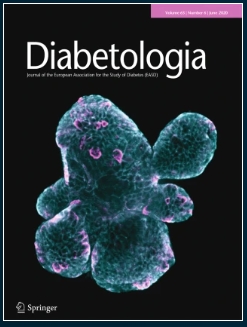Cideb knockdown in mice increases mitochondrial fat oxidation and reverses hepatic steatosis and insulin resistance by the plasma membrane sn-1,2-DAGs-PKCε-insulin receptor kinaseT1150 pathway.
IF 10.2
1区 医学
Q1 ENDOCRINOLOGY & METABOLISM
引用次数: 0
Abstract
AIMS/HYPOTHESIS CIDEB (cell death-inducing DFF45-like effector B) deficiency is associated with a reduced incidence of metabolic dysfunction-associated steatotic liver disease (MASLD) in humans; however, the underlying mechanism responsible for this protective effect remains unclear. METHODS C57BL/6J male mice were fed a high-fat diet (HFD) to recapitulate key aspects of MASLD and hepatic insulin resistance. Cideb knockdown (KD) was achieved using a 2'-O-methoxyethyl (MOE) antisense oligonucleotide (ASO). In vivo rates of hepatic mitochondrial gluconeogenesis and tricarboxylic acid (TCA) cycle flux were assessed by Q-Flux. The Comprehensive Lab Animal Monitoring System (CLAMS) was used to evaluate rates of whole-body energy expenditure. Hepatic and peripheric insulin sensitivity were evaluated using hyperinsulinaemic-euglycaemic clamp studies combined with radio-labelled isotopes. RESULTS We showed that Cideb ASO treatment increased rates of whole-body energy expenditure by ~25% and decreased hepatic triacylglycerol by ~65% in a HFD mouse model of MASLD compared with the wild-type mice. Cideb KD reduced hepatic fat content, which could mostly be attributed to increased rates of hepatic mitochondrial oxidation, in combination with reduced hepatic lipogenesis. Additionally, Cideb KD ameliorated HFD-induced insulin resistance, which could be attributed to decreased plasma membrane sn-1,2-diacylglycerols (DAGs)-protein kinase C (PKC)ε-insulin receptor kinase (IRK)T1150 phosphorylation in liver and skeletal muscle. CONCLUSIONS/INTERPRETATION These findings demonstrate that Cideb KD enhances mitochondrial fat oxidation and reduces hepatic lipogenesis, which in turn mitigates HFD-induced hepatic steatosis and insulin resistance via the plasma membrane sn-1,2-DAGs-PKCε-IRKT1150 pathway, highlighting its potential as a novel therapeutic approach for MASLD and type 2 diabetes.通过质膜sn-1,2- dags - pkc ε-胰岛素受体激酶1150通路,Cideb敲低小鼠增加线粒体脂肪氧化,逆转肝脏脂肪变性和胰岛素抵抗。
iscideb(细胞死亡诱导的dff45样效应物B)缺乏与人类代谢功能障碍相关的脂肪变性肝病(MASLD)发病率降低相关;然而,这种保护作用的潜在机制尚不清楚。方法采用高脂饲料(HFD)喂养sc57bl /6J雄性小鼠,以总结MASLD和肝脏胰岛素抵抗的关键方面。利用2'- o -甲氧基乙基(MOE)反义寡核苷酸(ASO)实现了Cideb敲低(KD)。采用Q-Flux法测定活体肝脏线粒体糖异生率和三羧酸循环通量。采用综合实验动物监测系统(CLAMS)评估全身能量消耗率。使用高胰岛素血症-血糖钳夹研究结合放射性标记同位素评估肝脏和外周胰岛素敏感性。结果我们发现,与野生型小鼠相比,Cideb ASO治疗使MASLD HFD小鼠模型的全身能量消耗率提高了~25%,肝脏甘油三酯含量降低了~65%。Cideb KD降低了肝脏脂肪含量,这主要归因于肝脏线粒体氧化率的增加,以及肝脏脂肪生成的减少。此外,Cideb KD还能改善hfd诱导的胰岛素抵抗,这可能与降低肝脏和骨骼肌质膜sn-1,2-二酰基甘油(DAGs)-蛋白激酶C (PKC)ε-胰岛素受体激酶(IRK)T1150的磷酸化有关。结论/解释这些研究结果表明,Cideb KD增强线粒体脂肪氧化并减少肝脏脂肪生成,从而通过质膜sn1,2 - dags - pkc ε- irkt1150途径减轻hfd诱导的肝脏脂肪变性和胰岛素抵抗,突出了其作为MASLD和2型糖尿病新治疗方法的潜力。
本文章由计算机程序翻译,如有差异,请以英文原文为准。
求助全文
约1分钟内获得全文
求助全文
来源期刊

Diabetologia
医学-内分泌学与代谢
CiteScore
18.10
自引率
2.40%
发文量
193
审稿时长
1 months
期刊介绍:
Diabetologia, the authoritative journal dedicated to diabetes research, holds high visibility through society membership, libraries, and social media. As the official journal of the European Association for the Study of Diabetes, it is ranked in the top quartile of the 2019 JCR Impact Factors in the Endocrinology & Metabolism category. The journal boasts dedicated and expert editorial teams committed to supporting authors throughout the peer review process.
 求助内容:
求助内容: 应助结果提醒方式:
应助结果提醒方式:


